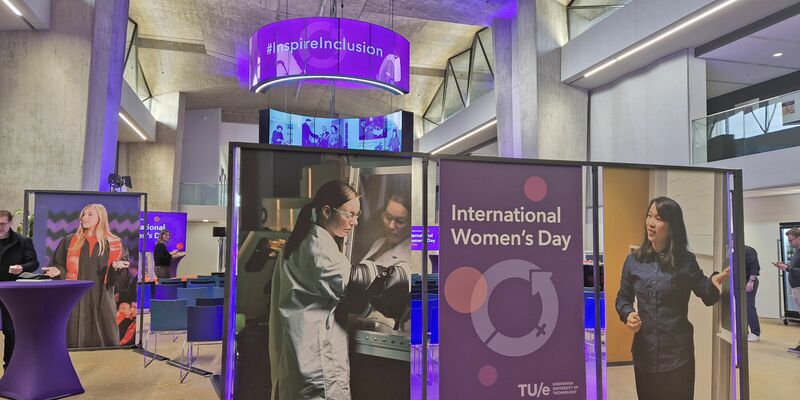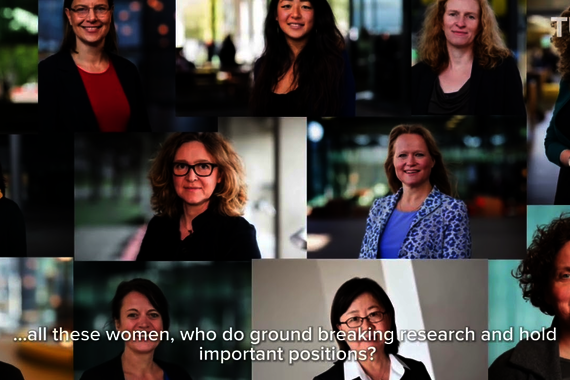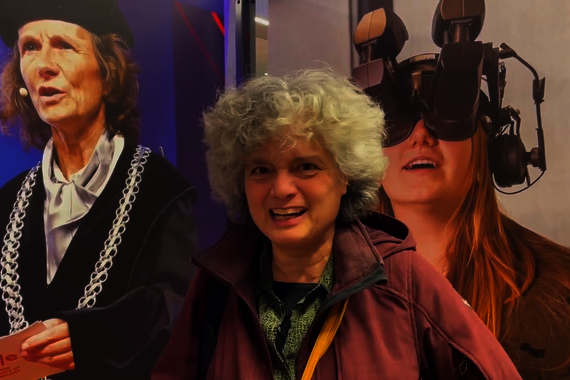
- The University
- 08/03/2024
The event was kicked off by a video message from Karien van Gennip, outgoing Minister of Social Affairs and Employment. “Tech companies still exist for most part of men. Isn't that odd? We do know that diverse teams work better. We must continue to raise the amount of women in boardrooms and in companies overall,” sounded her plea. She concluded by referring to the event: "We women are the center of this afternoon."
The first floor of the Atlas building is ostentatiously adorned with purple banners depicting women in technology. One of them is TU/e’s very own Rector Magnificus Silvia Lenaerts, in her academic robes. There is also a teacher pointing at a chalkboard mid-lecture and a woman in a lab coat, busy working on an experiment. The screens hanging over the stage read "#InspireInclusion in big white letters.
Care has been taken to avoid the color pink. Purple is the official color of International Women’s Day, but it also concerns a conscious choice by the event’s organizers. If one uses pink at a women’s event, it confirms the stereotype and that’s definitely not what today is about. It’s about women in science and technology working their way to the top despite all prejudices.
“We’ve come a long way”
The event pays tribute to female role models in the world of technology and at TU/e. Each speaker is given the floor for fifteen minutes, but first the audience is shown a video on 67 years of women’s rights at TU/e. Please click on the still below to watch this video.
The text continues underneath the video.
Rector Magnificus Silvia Lenaerts and President of the Executive Board Robert-Jan Smits are called to the stage. “We’re not there yet,” Smits hastens to emphasize. “We’ve come a long way and our target for the number of women full professors at the university has almost been achieved.”
Smits is referring to the target figure for women professors, which is 25 percent in 2025. The current percentage is 21.7. With just over 35 percent, the target for women assistant professors has already been achieved. The share of women associate professors is lagging behind, as shown by the timeline compiled by Cursor.
“When I started here, we had the lowest share of women academic staff out of all the universities in the Netherlands,” Smits continues. “That’s a position I really didn’t want to be in and I’m happy to report it’s no longer the case. We’re no longer bottom of the ranking.” The audience claps and starts laughing when Smits closes by saying: “Because Delft is.”
Lenaerts also has a message for all the women in the room: “You’re role models. Do what you love best out of all things. You can do anything. You can do the same as men, if not more. We’ll climb even further up the ranking. Why shouldn’t we strive for fifty percent women in academic staff? Why not more than that?” Lenaerts receives an applause from the room, which is packed out with predominantly women. In fact, it’s remarkable how few men there are: less than a dozen.
Women and health
One of those men is the first guest speaker at the event. Gynecologist Bas van Rijn of Máxima MC talks about gender’s enormous impact in the medical world. Women may be less prone to heart attacks, but also have a significantly lower survival rate. “That’s because there’s a gap between the health data of men and women. A lot less research has been done into women.”
Van Rijn mentions the ‘Hollywood heart attack’: a man clutches his chest and falls to the ground. “Everyone knows what’s going on right away and can come to the man’s aid. A heart attack looks different in women. They don’t experience chest pain quite as often, but may start experiencing shortness of breath, which people aren’t as quick to notice and which isn’t treated as efficiently.” Which is why Van Rijn concludes by calling for more money to reduce gender inequality in medical data.
Diversity and inclusion
TU/e’s own Chief Diversity Officer Evangelia Demerouti tells us how she got this position in 2017. At first she had one colleague with whom she worked together on the policy for greater diversity and inclusion. “Nowadays I see people everywhere engaging with the topic. This makes me very happy.” She stresses there’s a difference between diversity and inclusion. “Diversity is about numbers, about demographic characteristics. Inclusion is more vague. It’s about whether someone is involved in an organization and whether that person’s qualities are appreciated by the organization.”
Demerouti developed a leadership training course, which was recently launched for supervisors and other TU/e staff. It’s intended to teach them how to boost a team, with inclusion as a theme receiving extra attention.
Simac
Another guest speaker from outside the university is the brand-new CEO of Simac, Maartje van Schagen. She tells us how she took over her father’s company five months ago. A lot changed for her after getting the new job title. “I was really overwhelmed by all of the attention and recognition. Everyone wants to talk to you. You’re invited to all kinds of events. That really surprised me.”
Some people tried to belittle her or even tried to hide information from her thinking she wasn’t ready for it. When she put together a new management team, she immediately appointed two women. “They had been a bit invisible, but ever so talented. The other day they came up to me and told me that the three of us are really seen as role models by other women within the company, because we show them that you can really reach the highest level as a woman. That was an eye opener: my experiences can inspire others.” Schagen finishes with an appeal to all women in the room: “Embrace your individuality. Don’t be scared to show the world who you are.”
Jump!
The event ends with a ‘jump’ by Ineke Hurkmans of JumpMovement, who developed a scalable method for conversations that create movement and connectedness in organizations. Everyone can stay in their seats, because it’s more of a mental jump. It covers a total of seven steps, which those present have to carry out in pairs. They hold hands while telling each other about their greatest achievements. The exercise is intended to bring about a deep connection between one another, but also – and even more importantly – to recognize and celebrate the successes of all of the women in the room.
Cursor asked those present if International Women’s Day is really necessary. Watch the video below.


Discussion